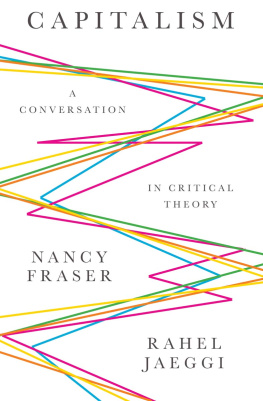Critical Technology
For Patricia Ann Kirkpatrick, 1943-1996
First published 2004 by Ashgate Publishing
Reissued 2018 by Routledge
2 Park Square, Milton Park, Abingdon, Oxon OX14 4RN
711 Third Avenue, New York, NY 10017, USA
Routledge is an imprint of the Taylor & Francis Group, an informa business
Graeme Kirkpatrick 2004
Graeme Kirkpatrick has asserted his right under the Copyright, Designs and Patents Act, 1988, to be identified as the author of this work.
All rights reserved. No part of this book may be reprinted or reproduced or utilised in any form or by any electronic, mechanical, or other means, now known or hereafter invented, including photocopying and recording, or in any information storage or retrieval system, without permission in writing from the publishers.
A Library of Congress record exists under LC control number: 2004007711
Notice:
Product or corporate names may be trademarks or registered trademarks, and are used only for identification and explanation without intent to infringe.
Publishers Note
The publisher has gone to great lengths to ensure the quality of this reprint but points out that some imperfections in the original copies may be apparent.
Disclaimer
The publisher has made every effort to trace copyright holders and welcomes correspondence from those they have been unable to contact.
ISBN 13: 978-0-815-38833-3 (hbk)
ISBN 13: 978-1-351-16064-3 (ebk)
Andrew Feenberg gave selflessly of his time and ideas to help me clarify the theoretical architecture of the book and I am particularly indebted to him. J.W.G. Wilson read the whole manuscript and provided many comments, some critical, all of them perceptive. Others helped in different ways at different points and this is the place to thank Helen Kennedy, Bo Kampmann Walther, Jon Dovey, John Armitage, Peter Wright, Michael Lavelle, Gordon Finlayson, Alan Carling, Chris Miles, Andrew McCulloch and Team CGS for their ideas, time and encouragement. Remaining faults with the work are, of course, entirely down to me.
Parts of some chapters have previously appeared in the journals Max Weber Studies ( is based on a paper that was presented to the Power-Up conference at University of West of England in Summer 2003 and to the annual game studies seminar at the University of Southern Denmark a few weeks later. I must thank the audiences at these events for their generous comments and criticisms.
Sarah Carling provided inspiration and adventure throughout the writing process. Natalia Hanley, Lynne Kirkpatrick, Christine Bisatt and Theodor Araby-Kirkpatrick gave solidarity and fun when I needed them. I am fortunate in having such friends and the book is for them. It is dedicated to the memory of my mother, who, along with my father, Jonty Kirkpatrick, always encouraged me to write.
This book is an academic text about a particular form of technology, but it is not a technical manual. Although it concerns interface design for the Personal Computer (PC), it is not a guide to good interface design - there are already too many of those. To some extent, this book is a critique of the ideas that underpin much of that literature. It is well understood within computer science that the way computers are presented to people is a vitally important aspect of that discipline. Only machines and, in particular, programs that are appropriately presented will be efficiently used and become viable products. In order to get this right, there is now an established sub-discipline, named Human-Computer Interaction (H-CI) that is given over to the analysis of how to make program interfaces that will facilitate the smooth integration of computers into the texture of everyday life for their intended users. H-CI is dominated, however, by established perspectives and paradigms in psychology, especially cognitivism. This means that program interfaces are being designed to work with a specific conception of the human as an individual and as a creature with a known set of capacities and endowments. The alternatives - interfaces for more than one person to use at a time; interfaces for people with non-standard sensory configurations or other physical endowments - tend to be left out of the picture. The result is technology design that comports well with the expectations of a society that has been reared on personal computing as the norm and which expects technology to come pre-packaged, mass marketed and attractive to its users. Anyone who is critical of that society and, in particular, of its tendency to wrap up human achievements as commodities for sale ought to be suspicious of this kind of technology design.
The book moves from this initial suspicion to develop a critique of the PC interface. That might seem like a perverse endeavour. PCs are, after all, associated with a revolutionary softening of the human experience of technology. Industrial machinery like cranes, rivets and production lines was brutal and its consequences, for the human beings who had to work with it, were frequently harsh and unpleasant. Computers may frustrate people but, repetitive strain injury aside, they do not place strenuous demands upon their physical systems. Indeed, one of the goals of interface design has, for some time, been to make computers user friendly and pleasant to use. It must be acknowledged that the intentions of interface designers are more often than not benign and that H-CI is actually an unusually humanistic discipline within the scientific and technical context. In a way, however, this makes interface design even more susceptible to social critique. What does it mean when a whole layer of people within the sphere of technical design begin actively to consult Aristotles poetics in their efforts to improve their work? When technology design is overtly informed by the need to create environments that are pleasurable and desirable for people to work in, then it enters into the realm of social and critical self-reflection. The humanities cannot service technology design with answers to its questions without also dragging technology and technologists into an engagement with their own concerns, which include the nature and meaning of pleasure, the importance of not finding things easy and the necessity of struggle in human affairs. Interface design becomes a field of controversy within the human sciences not simply because every arts professor has a PC on her desk but also because the way that machine was designed incorporates ideas drawn directly from her discipline. Until now this process has largely escaped the distinctive kind of philosophical mediation associated with critical theory of society. Interface design gurus have happily borrowed ideas of what people are like, about the nature of meaning and the desirability of some experiences over others, without encountering sustained resistance and debate from the disciplines that are centrally concerned with those questions. This book is an attempt to initiate that debate. In this, it is an intervention that tries to do what Habermas says philosophy must do in the current period, namely,
to mediate interpretively between expert knowledge and an everyday practice in need of orientation. What remains for philosophy is an illuminating further of lifeworld processes of achieving self-understanding, processes that are related to totality. For the lifeworld must be defended against extreme alienation at the hands of the objectivating, the moralising and the aestheticising interventions of expert cultures. (1992b: 17-18, emphasis in original)








